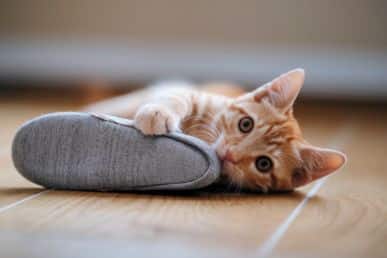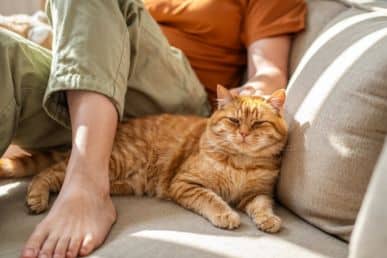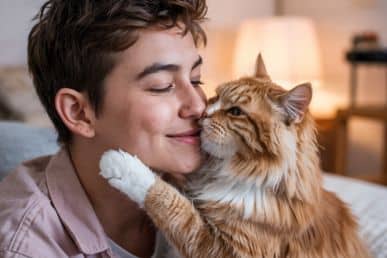Why Does My Cat Lick Me Then Bite Me? 5 Shocking Reasons

It can feel really puzzling when your cat gently licks your hand one second, then gives you a little bite the next! If you are a new cat owner, seeing this mixed signal will surely raise the question in your mind: Why Does My Cat Lick Me Then Bite Me?
So, why the lick-then-bite combo? This behavior is a form of communication. Think of it as your cat trying to tell you something important. Cats often lick you as a sign of affection or grooming, then bite to indicate overstimulation, playfulness, or a request for space.
It’s a normal part of feline body language and rarely means aggression. These are the common reasons cats express they need a bit of space or a change in activity. Understanding this behavior is like learning a secret code.
Cats don’t speak our words; they communicate through actions and body language. Learning to read these subtle behaviors is a super useful skill, especially because their signals are often much harder to notice than a dog’s wagging tail.
This communication is key to your relationship with your furry friend. Paying close attention helps you understand what your cat is trying to communicate in that moment, and also helps you make your cat more affectionate over time.
Keep reading to learn how to decode this quirky cat behavior — and how to respond in a way that strengthens your bond with your feline friend.
An Attack or a Way of Communicating?

It’s usually not an attack! For cats, that sudden little bite after gentle licking often has friendly reasons.
Think about kittens: they socialize and learn by exploring their world with their mouths, licking, and gentle biting in a totally non-aggressive manner while playing with siblings or mom. This playful habit often applies to adult cats, too.
They might be showing they were happy, but now feel overstimulated or want the petting session to stop. It’s one way they communicate with their humans, saying, “That’s enough attention for now,” even if it was pleasant before!
This mixed signal confuses many people, making them think their cat got angry out of nowhere. That moment where a cat gently licks you, then nips your hand — or even bites your nose — is actually more common than you’d think. Sometimes, though, a bite can mean something else.
Very rarely, a cat might bite to assert dominance or respond if they feel like a threat, perhaps if they are scared or in pain.
They might also give a little nip to ask you to stop something unwanted, like holding them too tightly. But most of the time, that lick-then-nibble combo is just cat talk, not aggression!
5 Shocking Reasons why your cats lick and then bite
1. Affection: The Love Bite

Ever wonder why your kitty gives you licks and then a little bite? It’s super common and usually means love, not anger! Think of it like a love bite.
When cats groom each other with their rough tongues, it’s a big sign of affection. They’re trying to show they feel safe and pleasant with you, like you’re part of their family.
Sometimes, those gentle bites happen right after licks. This interaction is totally normal cat communication! It’s one of their special ways of showing they care.
Kittens do this when playing with siblings, so your grown-up cat might just be showing you that same friendly love. They want your attention and affection, but cats are also famously independent.
Samantha Bell, a cat expert from Best Friends Animal Society, says that a little bite might be their way of saying, “Although I am enjoying this interaction, you are going too far and you are about to cross my line.”
It’s not antisocial; it’s normal! They like your presence, especially when they want some love, but sometimes they have had enough cuddles. Think of it as their gentle way of asking nicely. It’s usually very soft, especially if they are trying to be sweet.
So next time your kitty gives you a love bite, know it’s a normal part of how they show they care. They might not want to be held right then, but they still like you!
2. Overstimulation: When Your Cat Wants You to Stop Petting
It starts out so nicely! Your cat might be happily purring while you’re petting them, maybe giving you a little lick. It feels like a sweet moment with your furry friend. But then, in the very next second, they suddenly bite!

You’re left confused, thinking, “What went wrong? I thought we were having fun!” This combo of lick-then-bite is a thing many cats do. It’s usually not because they’re upset with everyone or being picky, and definitely not because they’re a secret killer.
It often means they’re over-stimulated. All that nice petting builds up, and at a certain point, it becomes too much. They’ve simply had enough of your pets. That quick bite is their little way of saying, “Okay, friend, that’s great, but I want you to stop now!”
It’s like their signal to know it’s time to pull away or give them space. So, don’t worry; your cat isn’t being mean, they’re just asking politely (in cat language!) for a break.
What is Cat Overstimulation?
Believe it or not, that sweet licking turning into a sudden bite often happens because your cat gets too much of a good thing!
Petting feels enjoyable at first, but touch, especially in sensitive areas like their tummies, can become overwhelming if it goes on for extended periods of time.
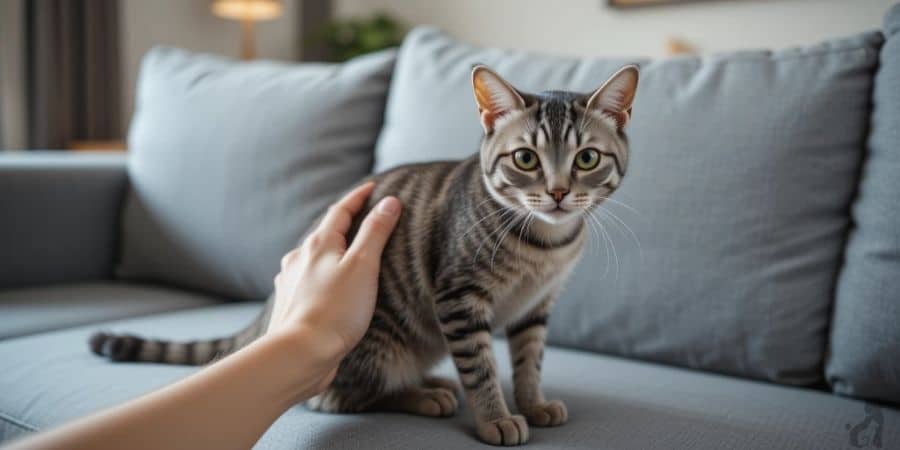
Every cat has their own overstimulation threshold – the point where nice petting turns frustrating. This differs from cat to cat; one might love long strokes, another reaches their limit quickly.
When they hit that threshold, the results are often a warning nip or bite. That’s why they might lick you (maybe grooming you or showing affection) for a few minutes, seeming to enjoy it, and then suddenly chomp! It’s crucial to pay attention to your cat’s responses while interacting and petting.
Be mindful of these things:
- Pet for short bursts. Think of a set timeframe (like just a minute or two) to keep things safe and fun.
- Notice sensitive spots. Many cats really don’t like long petting on their belly or near their back legs.
- Watch for sudden changes in behaviour. Twitching skin, tail lashing, ears flattening, or a tense body are signs to pay attention to and stop petting before they feel the need to bite or maybe even use a claw.
How to Avoid Overstimulating Your Cat
When you pet your cat, stick to calm areas they love, like their chin or cheeks—avoid sensitive spots! Watch for signs of discomfort, such as tail twitching or ears flattening. If you spot these, stop petting immediately to keep things peaceful.
I’ve found keeping affection sessions short (think 2-3 minutes) works wonders. Afterward, wait a little time before attempting cuddles again—this waiting break helps them reset.
Perfect timing matters too: if they seem tense, give them a bit of space. If they bite, never retaliate by yelling or punishing them. That only makes them afraid and more aggressive later.
Trust me, staying gentle is in their best interest!
3. Playtime! Your Cat Is Asking for Fun

Sometimes your cat’s lick turns into a gentle bite because they’re just in a super playful mood! Watch for signs like ears pointed forward, whiskers twitching, pupils dilated, or a tail held straight up.
You might even see them walking with an arched back, crouching low, or wiggling their rear end—all meaning they’re ready to pounce! This silly combo of licking and biting isn’t mysterious; cats often do it during playtime when they simply want to have fun with you.
It’s their way of asking for action! To keep things cool and safe, give them space when they get slightly too excited. Try fun interactive games like chasing a feather toy or using products they’ll enjoy, like the Lima Cat Tunnel or Figo Shelves.
These recommended toys let them leap and explore safely. Most importantly, spend one-on-one time playing together—it’s the playful reason they seem to start with licks, then pretend bites!
4. Grooming: Your Cat May Be Grooming You
It’s possible your cat is trying to groom you, just like they do with their siblings! Cats often lick each other to keep clean and rid their fur of dirt or tangles. This normal part of cat life shows they’re fond of you.
When your kitty licks you repetitively with their soft tongue, they see you as family, even though humans don’t have fur that needs getting untangled! Sometimes, after you’ve been groomed, a little bite happens.
Or they might nip with tiny bites! This seemingly odd interaction is usually their way of playing or saying, “All done!” Those gentle bites are a preferred cat move to tell you they’re happy, not mad. There’s no fear or mean intent—just love for their favorite people.
5. Stress: Your Cat May Be Stressed or Anxious
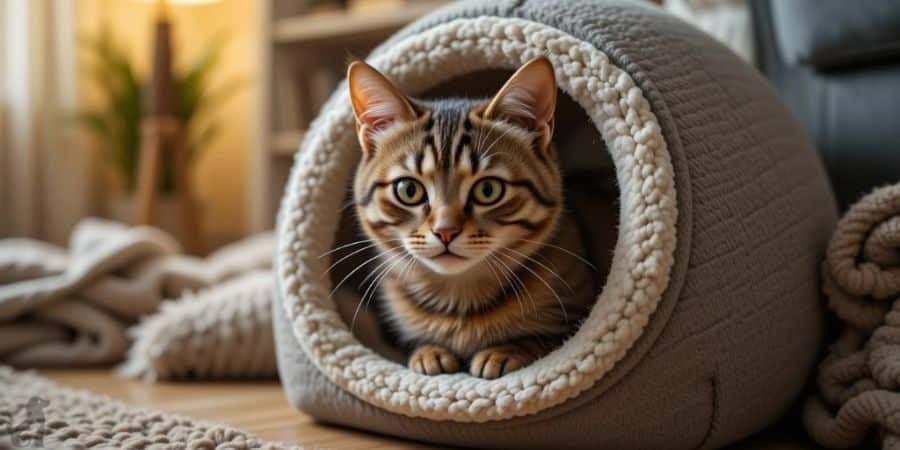
Sometimes, your furry friend might be feeling stressed or anxious. This anxiety can make them act strangely, like excessively licking you and then biting. It’s confusing! Your cat isn’t trying to be mean; they feel overwhelmed.
Look for other clues: are they hiding more, chewing on things they shouldn’t, or acting jumpy than usual? Cats need to feel safe. Naturally cautious, breeds like Siamese might be extra attentive to changes.
A new pet, loud noises, or even rearranged furniture can upset their world, making them display stress through this lick-then-bite trend.
Helping your cat relax is important. Create a calm, safe space just for them – think quiet hideaways with comfy, cushioned beds. These fluffy hideaway spots are great for sleeping and feeling secure, reducing their need to hide constantly.
Offer them high perches to watch the world safely. Try calming aids like special pheromone plugins. Spend quiet time together; gentle play can be supportive. If the aggression seems to be growing, or you see other worrying signs, consult your vet.
It’s a possible source of the problem, and they can check for a health diagnosis or suggest treatment. Your help makes their environment feel safer and more easily managed.
Remember, they want to feel calm and safe, just like people and other pets do. Providing a peaceful choice of spots is key.
If you want to know from an expert about Why Does My Cat Lick Me Then Bite Me, the video below is perfect for you.
Signs Your Cat Is Stressed:
- Excessive grooming
- Hiding or avoiding people
- Sudden aggression
- Refusing to eat or sleep normally
How to respond to a cat’s Licking Then Biting behavior?
| Do | Don’t |
|---|---|
| Observe body language | Yell or punish |
| Limit petting time | Force cuddles |
| Use redirection techniques | Ignore repeated hard bites |
| Offer break time | Misread signs as “meanness” |
Cat Licking Then Biting? When It’s a Red Flag
Most of the time, this behavior is harmless. But watch out for:
- Repeated biting with aggression or blood
- Avoidance behavior after the bite
- Growling or hissing was involved
If you experience any of these, consult your vet or a feline behaviorist. It might be a sign of pain, trauma, or deeper stress.
Does The Order of Licking or Biting Matter?
Absolutely, the order makes a big difference! Think of it like your cat’s special language. The sequence tells a story. Most cats do the lick-then-bite combo. This usually starts as sweet affection (the licking!), like grooming a friend.
But then, they might give a gentle bite as a way to say “stop” or “that’s enough petting now.” It’s their honest signal. The context matters too – were you petting their belly (bottom line: most cats don’t like that!) or just chilling?
If the order is flipped – bite then lick – it often means something else. That initial bite might be more like a playful nip or an alternate calling for attention, followed by licking to show they still like you.
So, the meaning above is explained by the sequence. People can tell what their cat needs by paying attention to this body language signal.
If you still don’t understand cat licking and biting behavior, perhaps the table below will help you.
| Behavior Pattern | Meaning | Action |
|---|---|---|
| Lick → Soft Bite | Affection, play | Pause or redirect |
| Lick → Hard Bite | Overstimulation | Stop petting now |
| Bite → Lick | Play → Reconciliation | Calm the interaction |
| Bite Only | Aggressive or pain-related | Monitor closely, vet check |
What To Do If the Bite Is Aggressive?
If your cat licks and then gives a hard, painful bite, it might signal real aggression, not just play. This behavior needs careful handling to stop it from escalating.
First, figure out what trigger caused it – were you petting a sensitive spot, or was the cat startled? Knowing this helps avoid those situations in the future.
Never shout (yelling) or swat (physical punishment), as this scares cats, makes them afraid, and actually makes their aggression worse. Instead:
- Stay calm and relaxed! Take a deep breath. Your calm manner helps your cat feel safer and less likely to behave aggressively.
- Gently stop interacting. Move away slowly without fuss.
- Later, use positive reinforcement. When your cat is relaxed or gentle, reward that good behavior with praise, pets, or a special treat. This encourages them to act nicely.
- Some cats are more prone to overstimulation bites. Watch closely during petting and stop before they get too excited. How you handle these moments really matters for building trust.
Conclusion:
Figuring out “why does my cat lick me then bite me” is like learning a secret cat code! Cats are fascinating creatures with their own world of body language.
Their licking often starts as pure love and affection, a way to show they care about you, their favorite human beings. Think of it like gentle petting from them.
But sometimes, that soft lick turns into a little biting. This sudden switch isn’t usually a big concern or means they stopped loving you. It’s often just how they communicate! Your cat might be saying:
- “I love this attention, but now I’m done and need some alone time.” (They get overstimulated).
- “This petting feels too intense now!” (Petting-induced overstimulation).
- “Let’s play! That bite is my playful feeling coming out!”
It takes effort to decipher what your pets are telling us. This licking followed by biting is a normal way cats interact and communicate with us. It’s part of their unique interaction style. Learning to read these subtle signs helps us understand our furry friends better. Just remember, it’s rarely personal – it’s just cat talk!
💬 “Has your cat ever licked you and then bitten you? Share your experience in the comments below — every cat has a unique way of communicating, and we’d love to hear your story!”
Frequently Asked Questions
What does it mean if a cat licks you, then bites you?
Your cat might lick and then bite to communicate a message. Often, they get overstimulated during petting and signal you to stop. Or, they initiate play—licking shows affection, but a gentle nip means “Let’s play!” Sometimes, grooming helps prepare for playful bites.
Why does my cat lick me, then bite me gently?
It’s often affection mixed with playful energy! The lick shows love, like saying “You’re mine!” The soft bite is usually playful behavior, like starting a fun game. Think of it as your cat’s excited way of interacting. Both reasons show your cat feels comfortable with you.
Is it bad if my cat licks and bites me?
Usually, it’s not bad! When cats start licking you, it’s often a sign of affection, like grooming. Sometimes, this gentle nibble or biting happens because of overstimulation – they just got too excited! This is harmless play. Real aggression is different and much fiercer.
How can I stop my cat from biting after licking?
When your cat starts licking and you feel those little teeth might come next, there are gentle ways to discourage the biting. First, watch their body language closely. If they seem twitchy or their skin ripples while you’re petting, especially on sensitive areas like their belly, stop petting before they feel the need to bite – this helps keep things calm. Instead, immediately redirect their attention to something fun and appropriate, like chasing a wand toy or batting a ball; offering these activities shifts their energy away from your hand. Also, make sure your cat has a stimulating environment with plenty of their own toys to play with, so they’re less likely to get overexcited during cuddles. When they lick without biting afterwards, use positive reinforcement! Quickly give them yummy treats to encourage that good behavior. This teaches them that gentle licks, not nips, get the best rewards.
Can cats bite due to jealousy or attention-seeking?
Absolutely! Your cat might feel excluded if your attention is diverted to another person or pet. This jealousy can trigger biting. Often, nibbling is simply attention-seeking behavior. Your cat uses this way to communicate, express its desires, or signal that it needs interaction. Gentle biting tells you about their needs.
Why does my cat lick and bite my mouth?
Cats often show licking followed by biting toward their owners. It’s usually normal, playful affection—they might purr too! But if overstimulated, gentle nips can turn aggressive. Your feline may seek attention this way. If frequent, ask a vet or behaviourist for advice.

